Two-Stage Delivery System for Last Mile Logistics in Rural Areas: Truck–Drone Approach
Abstract
1. Introduction
- (1)
- The transportation distance is long, and customers are scattered in rural areas with vast terrain. The sparse distribution of customers not only leads to longer transportation distances and more difficult logistics distribution but also requires logistics companies to formulate more complex and flexible strategies in resource planning and route optimization.
- (2)
- Complex geographical environments and poor road conditions. The rural geographical environment is complex, the terrain is undulating, the mountain roads are rugged, and road conditions are often poor across rivers, which also affects the speed and safety of rural cargo transportation.
- (3)
- Shortage of human resources. There is a shortage of human resources in rural areas and a lack of professional logistics personnel, making it difficult to ensure the quality and efficiency of logistics.
2. Literature Review
2.1. Rural Last Mile Logistics for Long Distance and High Cost
2.2. Drone Logistics Saves Costs and Energy
2.3. Truck–Drone Coordinated Operations and Algorithms
3. Research Problem Description
4. Mathematical Modeling
4.1. Model Assumption
- (1)
- The performance and load of every truck and drone are fixed.
- (2)
- A truck or a drone only serves one customer at a time.
- (3)
- The truck will not break down or be delayed during transportation, and it will not be affected by external factors such as traffic congestion.
- (4)
- The flying speed and altitude of the drone are fixed, and the driving path of the truck is processed according to the city street grid, and the driving path of the drone is a straight line.
- (5)
- The trucks and drones reach every customer, regardless of the obstacle avoidance and charging problems of the drones.
- (6)
- Trucks can only start from the distribution center, arrive at the designated customers along a delivery route, then fly the drone and finally return to the original distribution center.
4.2. Parameter Setting
4.3. Model Building
5. Algorithm
5.1. FCM Algorithm
- (1)
- Initialization: Optimize and select sample points as the initial clustering center. Due to the sensitivity of the initial clustering center of the FCM algorithm, sample points is used to select the initial clustering center. For minimum values , let the clustering centers of the class generated by the algorithm in the th and iterations, respectively, be recorded as and . is the number of clusters, let the difference between the two be , if . Then, define the cluster center as a stable cluster center, and do not calculate the new cluster center of the class in the next iteration. Otherwise, define it as an active cluster center, and continue to calculate the new cluster center of this class in the next iteration and calculate to determine whether it is a stable cluster center. Until all clustering centers are stable clustering centers, the optimal initial clustering center is obtained.
- (2)
- Calculate the degree of membership: For each sample point, calculate its distance to each cluster center, and determine the degree to which it belongs to each cluster based on the distance. The degree of membership is as shown in Formula (20). The membership degree of the FCM algorithm refers to the membership degree of sample in class . According to the provisions of the FCM algorithm, the sum of the membership degrees of samples in each class is 1. The iterative formula for membership degree is shown in (21). The goal of the FCM algorithm is to make the objective function of Formula (22) converge to a certain value or lower than a certain threshold, or to make the difference of between the two iterations lower than a certain value or reach the specified number of iterations, at which point the operation is terminated.
- (3)
- Update clustering center: Recalculate the clustering center of each cluster based on the membership degrees of all sample points. The clustering center in FCM is different from the traditional clustering center in that it uses the membership degree as the weight to make a weighted average. The iteration formula of the cluster center is shown in (23).
- (4)
- Determine convergence: If the change in the cluster center is less than a certain threshold or reaches the maximum number of iterations then stop the iteration; otherwise, return to step (2) to continue execution.
5.2. Genetic Annealing Algorithm
- (1)
- Set initialization parameters: population size , number of inner loops , the initial temperature , cooling coefficient λ, crossover probability , and mutation probability .
- (2)
- Generate the initial population: the truck stop numbers are sequentially encoded on chromosomes, and chromosomes of length are randomly generated ( is the number of truck stops).
- (3)
- Calculate individual fitness: The fitness function is used to measure the excellence of the chromosomes in the population. The larger the fitness value, the better the individual. The objective function is to minimize the cost, so the total operating cost of each truck and drone joint delivery solution calculated by Formula (1) is used as the fitness .
- (4)
- Genetic operators: selection operators, crossover operators, and mutation operators. The tournament method is used to select individuals with high fitness in the current population, and offspring are generated using sequential crossover with probability . To maintain the diversity of the population, individuals are mutated with probability , and the fitness of individuals in the new population is calculated as .
- (5)
- Simulated annealing operation: According to the Metropolis acceptance criterion in simulated annealing, the individuals in the new population are annealed to achieve the replacement of the old and new populations. If , the new individual will replace the old individual; otherwise, the new individual will be accepted with probability .
- (6)
- Determine the termination condition: If the number of iterations reaches , stop the loop and output the optimal solution. Otherwise, follow to cool down and go to step (3) to continue calculation, or until the termination temperature is reached. According to the above steps, the flow chart of the genetic simulated annealing algorithm is shown in Figure 3.
5.2.1. Encoding Method
5.2.2. Bequeathed Progressive Strategies
6. Simulation and Results Discussion
6.1. Parameter Settings
6.2. Analysis of Simulation Results
7. Conclusions
Author Contributions
Funding
Data Availability Statement
Conflicts of Interest
Appendix A
| Algorithm A1 Improved FCM algorithm | |
| Input: | village dataset with features (demand, distance to township); number of clusters ; convergence threshold ; |
| Output: | optimal cluster centers {} representing the final clustering solution; |
| randomly select data points from the village dataset as initial cluster centers ; | |
| compute membership matrix using the traditional FCM algorithm | |
| iterate until convergence or a maximum number of iterations | |
| compute the membership values for each village point and cluster center using the Formula (23); | |
| update the cluster centers using the Formula (25); | |
| check for convergence by calculating the change in cluster centers or membership matrix; | |
| the change is below a predefined threshold | |
| exit the iteration; | |
| set ; | |
| each cluster center | |
| set is stable = false; | |
| iterate to compute new cluster centers | |
| repeat steps 4 to 8 to update based on the membership matrix ; | |
| calculate , where is the cluster center from the previous iteration; | |
| if | |
| mark as a stable cluster center, set is stable = true; | |
| update to max(); | |
| < | |
| {}; | |
| repeat steps 2–19; | |
| Algorithm A2 Simulates genetic annealing algorithm | |
| Input: | = population size; = number of inner loops; = initial temperature; = cooling coefficient; = crossover probability; = mutation probability; num _drones = n; = num of {}; |
| % Generate the initial population | |
| chromosomes = randi ([1, ], , ); % Randomly generate chromosomes of length | |
| % Main Optimization Loop | |
| iteration = 1:M | |
| % Genetic Operations | |
| % Selection using tournament method | |
| selected _ indices = tournament _ selection (chromosomes, ); | |
| % Crossover with probability | |
| Crossover _ indices = rand (1, ) < ; | |
| offspring = sequential _ crossover (chromosomes (selected _ indices, :), crossover_indices); | |
| % Mutation with probability | |
| mutation _ indices = rand (1, N) < ; | |
| mutated _ offspring = mutate (offspring, mutation _ indices, ); | |
| % Calculate fitness for the new population | |
| new _ fitness = calculate _ fitness (mutated _ offspring); | |
| % Simulated Annealing Operation | |
| = 1: N | |
| new _ fitness () > calculate _ fitness (chromosomes (selected _indices (), :)) || rand () < exp ((calculate _ fitness (chromosomes (selected _ indices (), :))—new_fitness ()) / ) | |
| chromosomes (selected _ indices (), :) = mutated_offspring (, :); | |
| % Cooling Down | |
| = lambda × ; | |
| Output: | |
| % Find the best solution in the final population | |
| [~, best _index] = max (calculate _fitness(chromosomes)); | |
| Optimal _solution = chromosomes (best _index, :); | |
| % Separate delivery points for each drone | |
| drone _delivery _points = cell (num _drones, 1); | |
| drone = 1: num _drones then | |
| drone _delivery _points {drone} = find (optimal _solution == drone); | |
| % Output the optimal solution for each drone | |
| (‘Optimal Delivery Points for Each Drone:’); | |
| drone = 1:num_drones then | |
| (‘Drone %d: %s\n’, drone, num2str (drone _delivery _points {drone})); | |
| %Genetic Operators | |
| function selected _indices = tournament _selection (chromosomes, ) | |
| % Tournament selection function | |
| % Selects individuals with high fitness in the current population | |
| % Mutation Operators | |
| function mutated _offspring = mutate (offspring, mutation _indices, ) | |
| % Mutation function | |
| % Applies different mutation operators (switch, swap, invert) based on probabilities | |
References
- China Sees Rapid Development in Rural E-Commerce. Available online: https://english.www.gov.cn/archive/statistics/202308/15/content_WS64db757fc6d0868f4e8de941.html (accessed on 12 January 2024).
- Liu, W. Route Optimization for Last-Mile Distribution of Rural E-Commerce Logistics Based on Ant Colony Optimization. IEEE Access 2020, 8, 12179–12187. [Google Scholar] [CrossRef]
- Macioszek, E. First and Last Mile Delivery—Problems and Issues. In Advanced Solutions of Transport Systems for Growing Mobility; Sierpiński, G., Ed.; Springer International Publishing: Cham, Switzerland, 2018; pp. 147–154. [Google Scholar]
- Liang, Y.-J.; Luo, Z.-X. A Survey of Truck–Drone Routing Problem: Literature Review and Research Prospects. J. Oper. Res. Soc. China 2022, 10, 343–377. [Google Scholar] [CrossRef]
- Caraballo, L.E.; Díaz-Báñez, J.M.; Maza, I.; Ollero, A. The Block-Information-Sharing Strategy for Task Allocation: A Case Study for Structure Assembly with Aerial Robots. Eur. J. Oper. Res. 2017, 260, 725–738. [Google Scholar] [CrossRef]
- Otto, A.; Agatz, N.; Campbell, J.; Golden, B.; Pesch, E. Optimization Approaches for Civil Applications of Unmanned Aerial Vehicles (UAVs) or Aerial Drones: A Survey. Networks 2018, 72, 411–458. [Google Scholar] [CrossRef]
- Aurambout, J.-P.; Gkoumas, K.; Ciuffo, B. Last Mile Delivery by Drones: An Estimation of Viable Market Potential and Access to Citizens across European Cities. Eur. Transp. Res. Rev. 2019, 11, 30. [Google Scholar] [CrossRef]
- Tokosh, J.; Chen, X. Delivery by Drone: Estimating Market Potential and Access to Consumers from Existing Amazon Infrastruture. Pap. Appl. Geogr. 2022, 8, 414–433. [Google Scholar] [CrossRef]
- Rejeb, A.; Rejeb, K.; Simske, S.J.; Treiblmaier, H. Drones for Supply Chain Management and Logistics: A Review and Research Agenda. Int. J. Logist. Res. Appl. 2023, 26, 708–731. [Google Scholar] [CrossRef]
- Murray, C.C.; Chu, A.G. The Flying Sidekick Traveling Salesman Problem: Optimization of Drone-Assisted Parcel Delivery. Transp. Res. Part C Emerg. Technol. 2015, 54, 86–109. [Google Scholar] [CrossRef]
- Drexl, M. Synchronization in Vehicle Routing—A Survey of VRPs with Multiple Synchronization Constraints. Transp. Sci. 2012, 46, 297–316. [Google Scholar] [CrossRef]
- El-Adle, A.M.; Ghoniem, A.; Haouari, M. The Cost of Carrier Consistency: Last-Mile Delivery by Vehicle and Drone for Subscription-Based Orders. J. Oper. Res. Soc. 2023, 1–20. [Google Scholar] [CrossRef]
- Zou, B.; Wu, S.; Gong, Y.; Yuan, Z.; Shi, Y. Delivery Network Design of a Locker-Drone Delivery System. Int. J. Prod. Res. 2023, 1–25. [Google Scholar] [CrossRef]
- Pan, J.-S.; Song, P.-C.; Chu, S.-C.; Peng, Y.-J. Improved Compact Cuckoo Search Algorithm Applied to Location of Drone Logistics Hub. Mathematics 2020, 8, 333. [Google Scholar] [CrossRef]
- Yang, F.; Dai, Y.; Ma, Z.-J. A Cooperative Rich Vehicle Routing Problem in the Last-Mile Logistics Industry in Rural Areas. Transp. Res. Part E Logist. Transp. Rev. 2020, 141, 102024. [Google Scholar] [CrossRef]
- Nikolić, I.; Milutinović, J.; Božanić, D.; Dobrodolac, M. Using an Interval Type-2 Fuzzy AROMAN Decision-Making Method to Improve the Sustainability of the Postal Network in Rural Areas. Mathematics 2023, 11, 3105. [Google Scholar] [CrossRef]
- Niemeijer, R.; Buijs, P. A Greener Last Mile: Analyzing the Carbon Emission Impact of Pickup Points in Last-Mile Parcel Delivery. Renew. Sustain. Energy Rev. 2023, 186, 113630. [Google Scholar] [CrossRef]
- Nadimuthu, L.P.R.; Victor, K. Environmental Friendly Micro Cold Storage for Last-Mile Covid-19 Vaccine Logistics. Environ. Sci. Pollut. Res. 2022, 29, 23767–23778. [Google Scholar] [CrossRef] [PubMed]
- Yang, T.; Chu, Z.; Wang, B. Feasibility on the Integration of Passenger and Freight Transportation in Rural Areas: A Service Mode and an Optimization Model. Socio-Econ. Plan. Sci. 2023, 88, 101665. [Google Scholar] [CrossRef]
- Jiang, X.; Wang, H.; Guo, X.; Gong, X. Using the FAHP, ISM, and MICMAC Approaches to Study the Sustainability Influencing Factors of the Last Mile Delivery of Rural E-Commerce Logistics. Sustainability 2019, 11, 3937. [Google Scholar] [CrossRef]
- Kou, X.; Zhang, Y.; Long, D.; Liu, X.; Qie, L. An Investigation of Multimodal Transport for Last Mile Delivery in Rural Areas. Sustainability 2022, 14, 1291. [Google Scholar] [CrossRef]
- Dorling, K.; Heinrichs, J.; Messier, G.G.; Magierowski, S. Vehicle Routing Problems for Drone Delivery. IEEE Trans. Syst. Man Cybern. Syst. 2017, 47, 70–85. [Google Scholar] [CrossRef]
- Rabta, B.; Wankmüller, C.; Reiner, G. A Drone Fleet Model for Last-Mile Distribution in Disaster Relief Operations. Int. J. Disaster Risk Reduct. 2018, 28, 107–112. [Google Scholar] [CrossRef]
- Shao, J.; Cheng, J.; Xia, B.; Yang, K.; Wei, H. A Novel Service System for Long-Distance Drone Delivery Using the “Ant Colony+A*” Algorithm. IEEE Syst. J. 2021, 15, 3348–3359. [Google Scholar] [CrossRef]
- Yuan, X.; Zhu, J.; Li, Y.; Huang, H.; Wu, M. An Enhanced Genetic Algorithm for Unmanned Aerial Vehicle Logistics Scheduling. IET Commun. 2021, 15, 1402–1411. [Google Scholar] [CrossRef]
- Wang, Y.; Wang, L.; Peng, Z.; Chen, G.; Cai, Z.; Xing, L. A Multi Ant System Based Hybrid Heuristic Algorithm for Vehicle Routing Problem with Service Time Customization. Swarm Evol. Comput. 2019, 50, 100563. [Google Scholar] [CrossRef]
- Spliet, R.; Dabia, S.; Van Woensel, T. The Time Window Assignment Vehicle Routing Problem with Time-Dependent Travel Times. Transp. Sci. 2018, 52, 261–276. [Google Scholar] [CrossRef]
- Hossain, N.U.I.; Nur, F.; Hosseini, S.; Jaradat, R.; Marufuzzaman, M.; Puryear, S.M. A Bayesian Network Based Approach for Modeling and Assessing Resilience: A Case Study of a Full Service Deep Water Port. Reliab. Eng. Syst. Saf. 2019, 189, 378–396. [Google Scholar] [CrossRef]
- Ha, Q.M.; Deville, Y.; Pham, Q.D.; Hà, M.H. On the Min-Cost Traveling Salesman Problem with Drone. Transp. Res. Part C Emerg. Technol. 2018, 86, 597–621. [Google Scholar] [CrossRef]
- Kirschstein, T. Comparison of Energy Demands of Drone-Based and Ground-Based Parcel Delivery Services. Transp. Res. Part D Transp. Environ. 2020, 78, 102209. [Google Scholar] [CrossRef]
- Raghunatha, A.; Lindkvist, E.; Thollander, P.; Hansson, E.; Jonsson, G. Critical Assessment of Emissions, Costs, and Time for Last-Mile Goods Delivery by Drones versus Trucks. Sci. Rep. 2023, 13, 11814. [Google Scholar] [CrossRef]
- Elsayed, M.; Mohamed, M. The Impact of Airspace Regulations on Unmanned Aerial Vehicles in Last-Mile Operation. Transp. Res. Part D Transp. Environ. 2020, 87, 102480. [Google Scholar] [CrossRef]
- Kim, S.; Moon, I. Traveling Salesman Problem With a Drone Station. IEEE Trans. Syst. Man Cybern. Syst. 2019, 49, 42–52. [Google Scholar] [CrossRef]
- Enthoven, D.L.J.U.; Jargalsaikhan, B.; Roodbergen, K.J.; uit het Broek, M.A.J.; Schrotenboer, A.H. The Two-Echelon Vehicle Routing Problem with Covering Options: City Logistics with Cargo Bikes and Parcel Lockers. Comput. Oper. Res. 2020, 118, 104919. [Google Scholar] [CrossRef]
- Park, J.; Kim, S.; Suh, K. A Comparative Analysis of the Environmental Benefits of Drone-Based Delivery Services in Urban and Rural Areas. Sustainability 2018, 10, 888. [Google Scholar] [CrossRef]
- Kim, S.J.; Lim, G.J.; Cho, J.; Côté, M.J. Drone-Aided Healthcare Services for Patients with Chronic Diseases in Rural Areas. J. Intell. Robot. Syst. 2017, 88, 163–180. [Google Scholar] [CrossRef]
- Moshref-Javadi, M.; Hemmati, A.; Winkenbach, M. A Truck and Drones Model for Last-Mile Delivery: A Mathematical Model and Heuristic Approach. Appl. Math. Model. 2020, 80, 290–318. [Google Scholar] [CrossRef]
- Kitjacharoenchai, P.; Ventresca, M.; Moshref-Javadi, M.; Lee, S.; Tanchoco, J.M.A.; Brunese, P.A. Multiple Traveling Salesman Problem with Drones: Mathematical Model and Heuristic Approach. Comput. Ind. Eng. 2019, 129, 14–30. [Google Scholar] [CrossRef]
- Wang, D.; Hu, P.; Du, J.; Zhou, P.; Deng, T.; Hu, M. Routing and Scheduling for Hybrid Truck-Drone Collaborative Parcel Delivery With Independent and Truck-Carried Drones. IEEE Internet Things J. 2019, 6, 10483–10495. [Google Scholar] [CrossRef]
- Silva, D.F.; Smith, A.E. Sustainable Last Mile Parcel Delivery and Return Service Using Drones. Eng. Appl. Artif. Intell. 2023, 124, 106631. [Google Scholar] [CrossRef]
- Zhou, H.; Qin, H.; Zhang, Z.; Li, J. Two-Echelon Vehicle Routing Problem with Time Windows and Simultaneous Pickup and Delivery. Soft Comput. 2022, 26, 3345–3360. [Google Scholar] [CrossRef]
- Salama, M.; Srinivas, S. Joint Optimization of Customer Location Clustering and Drone-Based Routing for Last-Mile Deliveries. Transp. Res. Part C Emerg. Technol. 2020, 114, 620–642. [Google Scholar] [CrossRef]
- Rave, A.; Fontaine, P.; Kuhn, H. Drone Location and Vehicle Fleet Planning with Trucks and Aerial Drones. Eur. J. Oper. Res. 2023, 308, 113–130. [Google Scholar] [CrossRef]
- Karakatič, S.; Podgorelec, V. A Survey of Genetic Algorithms for Solving Multi Depot Vehicle Routing Problem. Appl. Soft Comput. 2015, 27, 519–532. [Google Scholar] [CrossRef]
- Prajapati, D.; Chan, F.T.S.; Daultani, Y.; Pratap, S. Sustainable Vehicle Routing of Agro-Food Grains in the e-Commerce Industry. Int. J. Prod. Res. 2022, 60, 7319–7344. [Google Scholar] [CrossRef]
- Ha, Q.M.; Deville, Y.; Pham, Q.D.; Hà, M.H. A Hybrid Genetic Algorithm for the Traveling Salesman Problem with Drone. J. Heuristics 2020, 26, 219–247. [Google Scholar] [CrossRef]
- Sacramento, D.; Pisinger, D.; Ropke, S. An Adaptive Large Neighborhood Search Metaheuristic for the Vehicle Routing Problem with Drones. Transp. Res. Part C Emerg. Technol. 2019, 102, 289–315. [Google Scholar] [CrossRef]
- Euchi, J.; Sadok, A. Hybrid Genetic-Sweep Algorithm to Solve the Vehicle Routing Problem with Drones. Phys. Commun. 2021, 44, 101236. [Google Scholar] [CrossRef]
- Wang, Y.; Yang, X.; Chen, Z. An Efficient Hybrid Graph Network Model for Traveling Salesman Problem with Drone. Neural Process Lett. 2023, 55, 10353–10370. [Google Scholar] [CrossRef]
- Wu, X.; Yin, Y.; Xu, L.; Wu, X.; Meng, F.; Zhen, R. MULTI-UAV Task Allocation Based on Improved Genetic Algorithm. IEEE Access 2021, 9, 100369–100379. [Google Scholar] [CrossRef]
- Zhou, Z.; Luo, D.; Shao, J.; Xu, Y.; You, Y. Immune Genetic Algorithm Based Multi-UAV Cooperative Target Search with Event-Triggered Mechanism. Phys. Commun. 2020, 41, 101103. [Google Scholar] [CrossRef]
- Tan, Y.; Li, S.; Liu, H.; Chen, P.; Zhou, Z. Automatic Inspection Data Collection of Building Surface Based on BIM and UAV. Autom. Constr. 2021, 131, 103881. [Google Scholar] [CrossRef]
- Ferrandez, S.M.; Harbison, T.; Weber, T.; Sturges, R.; Rich, R. Optimization of a Truck-Drone in Tandem Delivery Network Using k-Means and Genetic Algorithm. J. Ind. Eng. Manag. 2016, 9, 374–388. [Google Scholar] [CrossRef]
- Chang, Y.S.; Lee, H.J. Optimal Delivery Routing with Wider Drone-Delivery Areas along a Shorter Truck-Route. Expert Syst. Appl. 2018, 104, 307–317. [Google Scholar] [CrossRef]
- Cavani, S.; Iori, M.; Roberti, R. Exact Methods for the Traveling Salesman Problem with Multiple Drones. Transp. Res. Part C Emerg. Technol. 2021, 130, 103280. [Google Scholar] [CrossRef]
- Song, B.D.; Park, K.; Kim, J. Persistent UAV Delivery Logistics: MILP Formulation and Efficient Heuristic. Comput. Ind. Eng. 2018, 120, 418–428. [Google Scholar] [CrossRef]
- Saxena, A.; Prasad, M.; Gupta, A.; Bharill, N.; Patel, O.P.; Tiwari, A.; Er, M.J.; Ding, W.; Lin, C.-T. A Review of Clustering Techniques and Developments. Neurocomputing 2017, 267, 664–681. [Google Scholar] [CrossRef]
- Dokeroglu, T.; Sevinc, E.; Kucukyilmaz, T.; Cosar, A. A Survey on New Generation Metaheuristic Algorithms. Comput. Ind. Eng. 2019, 137, 106040. [Google Scholar] [CrossRef]
- Chen, P.-H.; Shahandashti, S.M. Hybrid of Genetic Algorithm and Simulated Annealing for Multiple Project Scheduling with Multiple Resource Constraints. Autom. Constr. 2009, 18, 434–443. [Google Scholar] [CrossRef]
- Yu, V.F.; Aloina, G.; Susanto, H.; Effendi, M.K.; Lin, S.-W. Regional Location Routing Problem for Waste Collection Using Hybrid Genetic Algorithm-Simulated Annealing. Mathematics 2022, 10, 2131. [Google Scholar] [CrossRef]
- Enayati, S.; Li, H.; Campbell, J.F.; Pan, D. Multimodal Vaccine Distribution Network Design with Drones. Transp. Sci. 2023, 57, 1069–1095. [Google Scholar] [CrossRef]
- Levin, M.W.; Rey, D. Branch-and-Price for Drone Delivery Service Planning in Urban Airspace. Transp. Sci. 2023, 57, 843–865. [Google Scholar] [CrossRef]
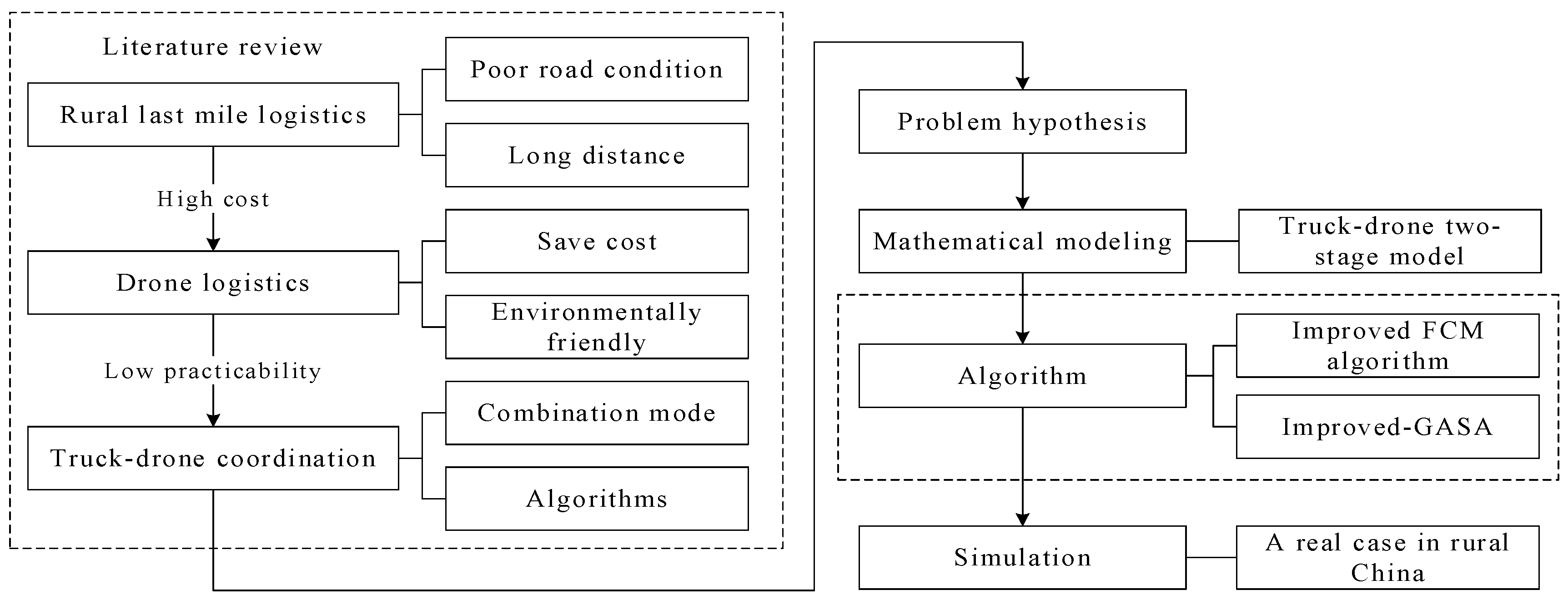
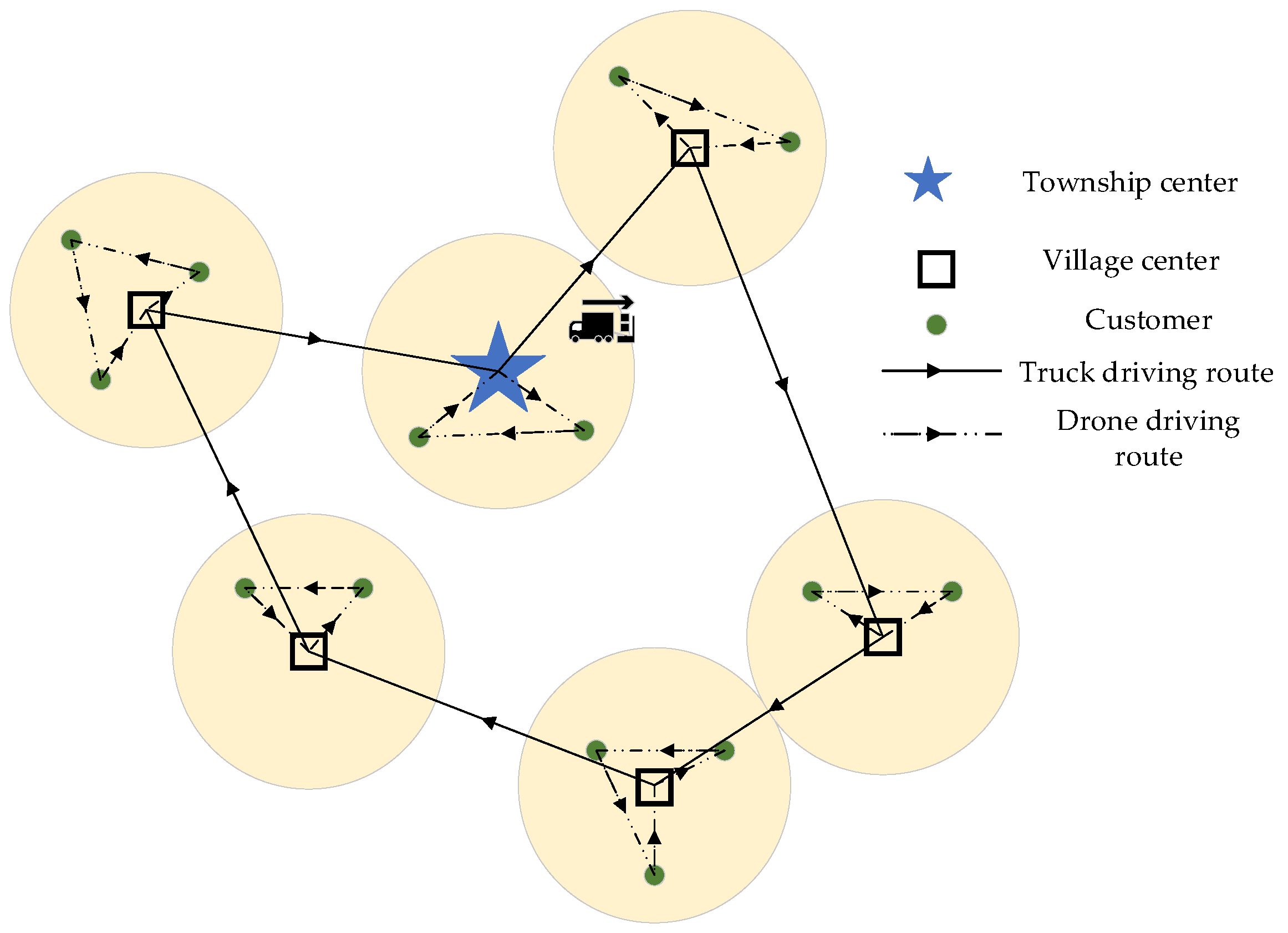



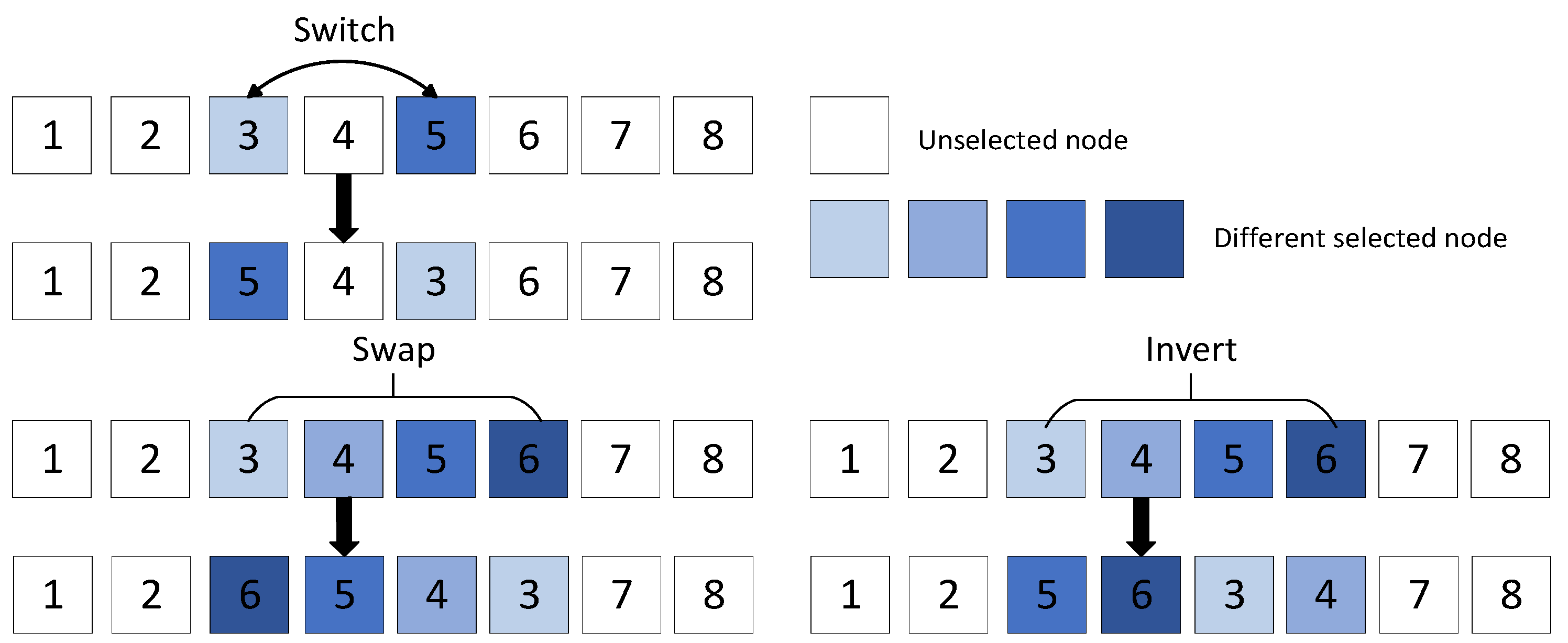
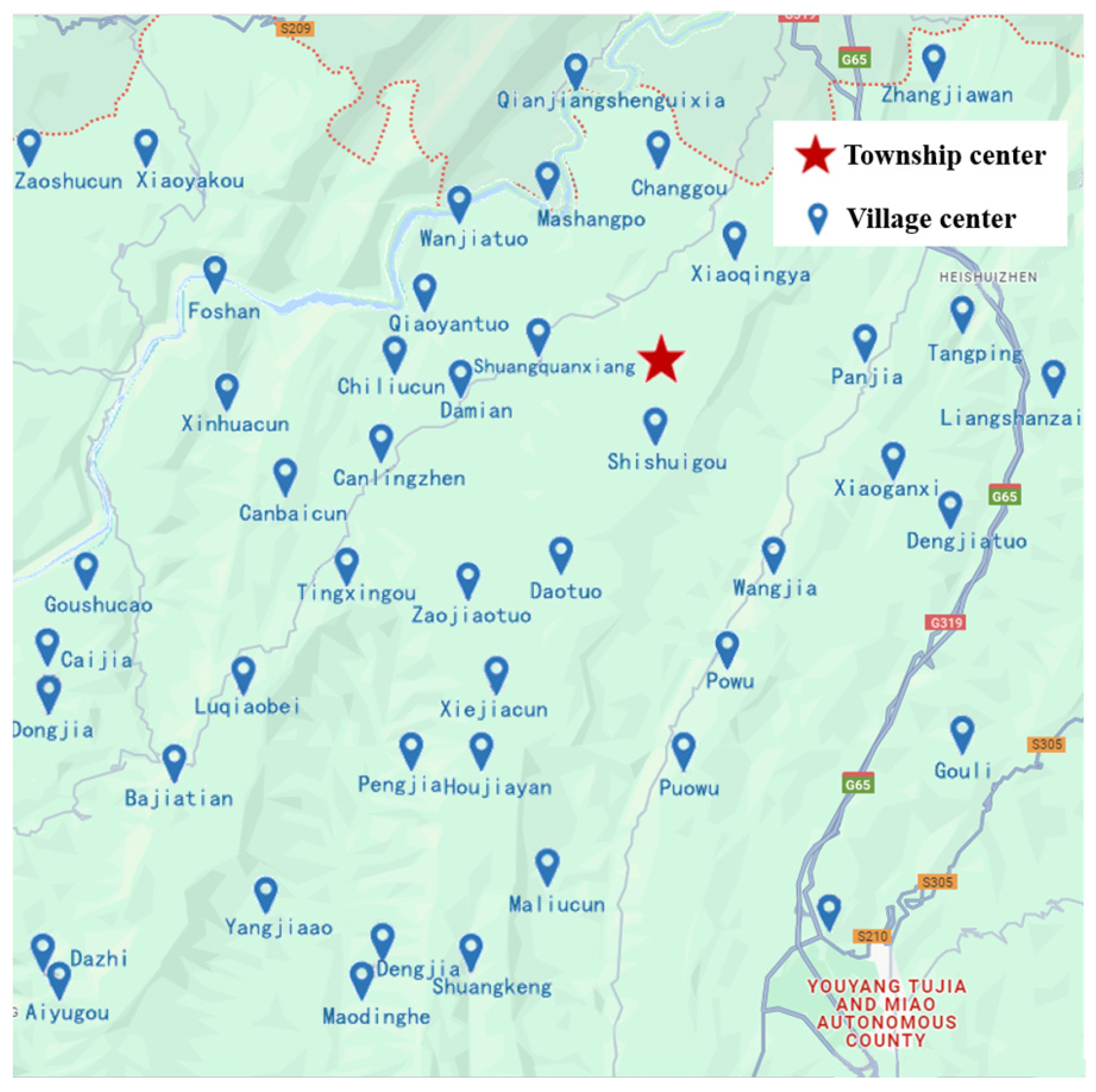
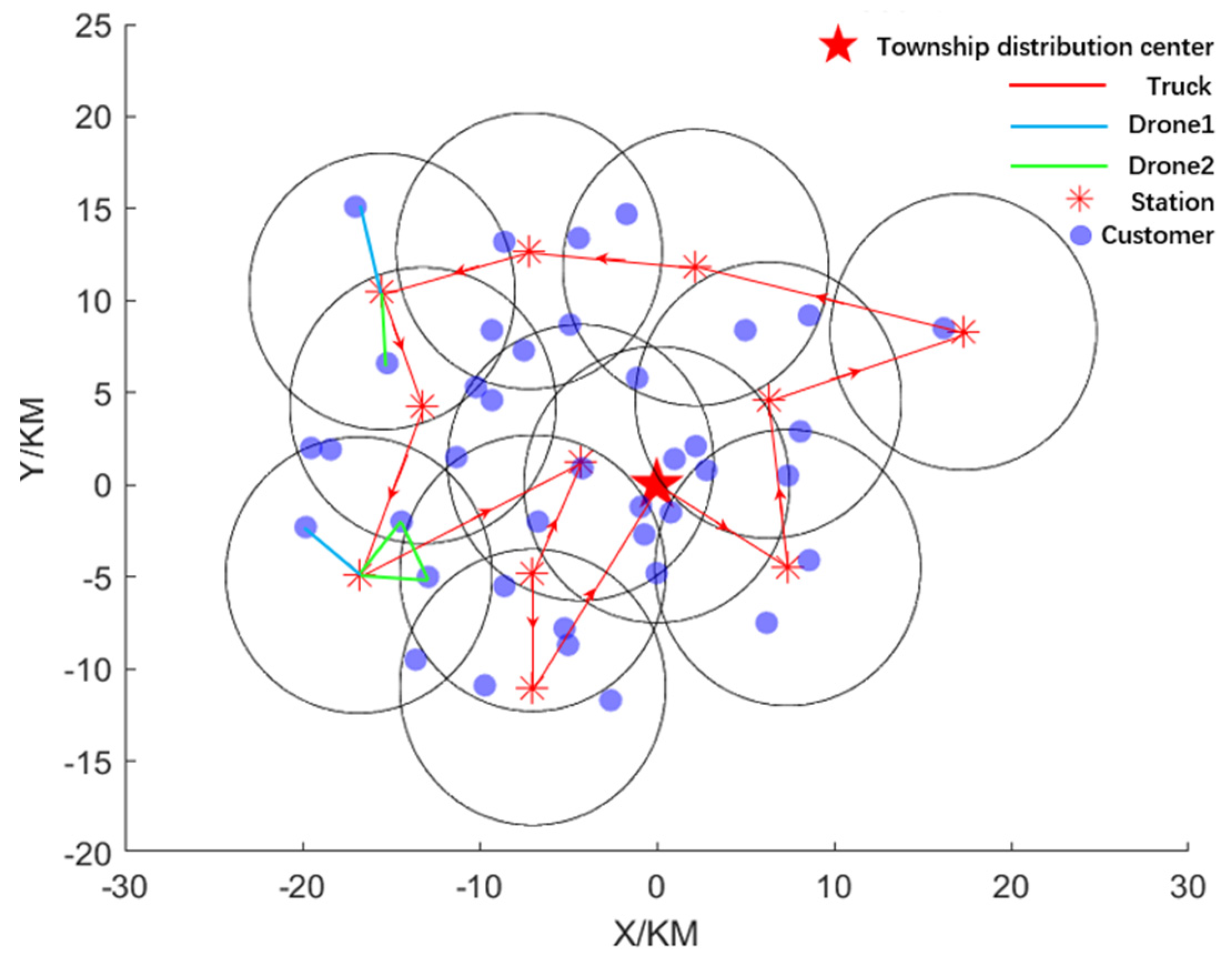
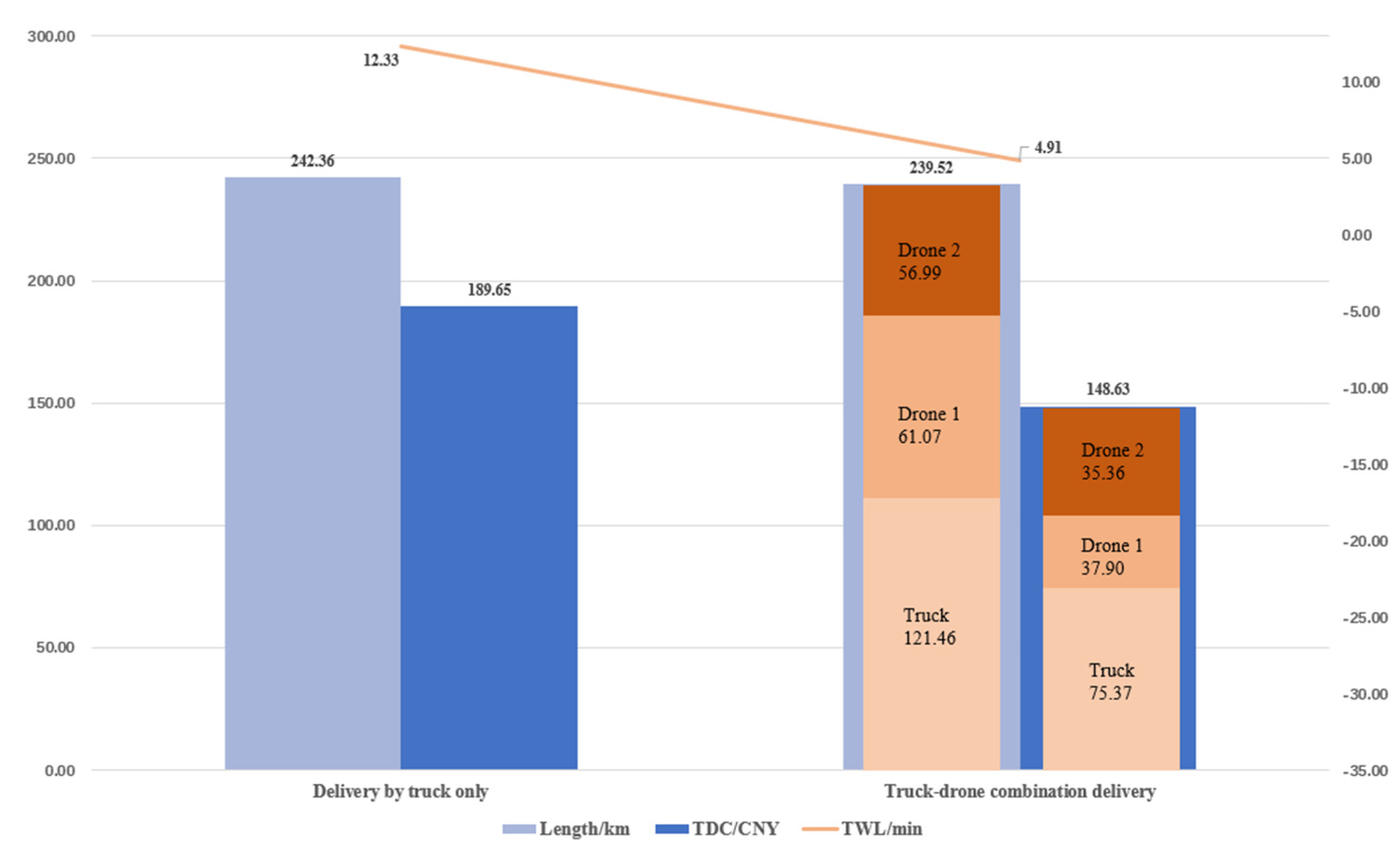
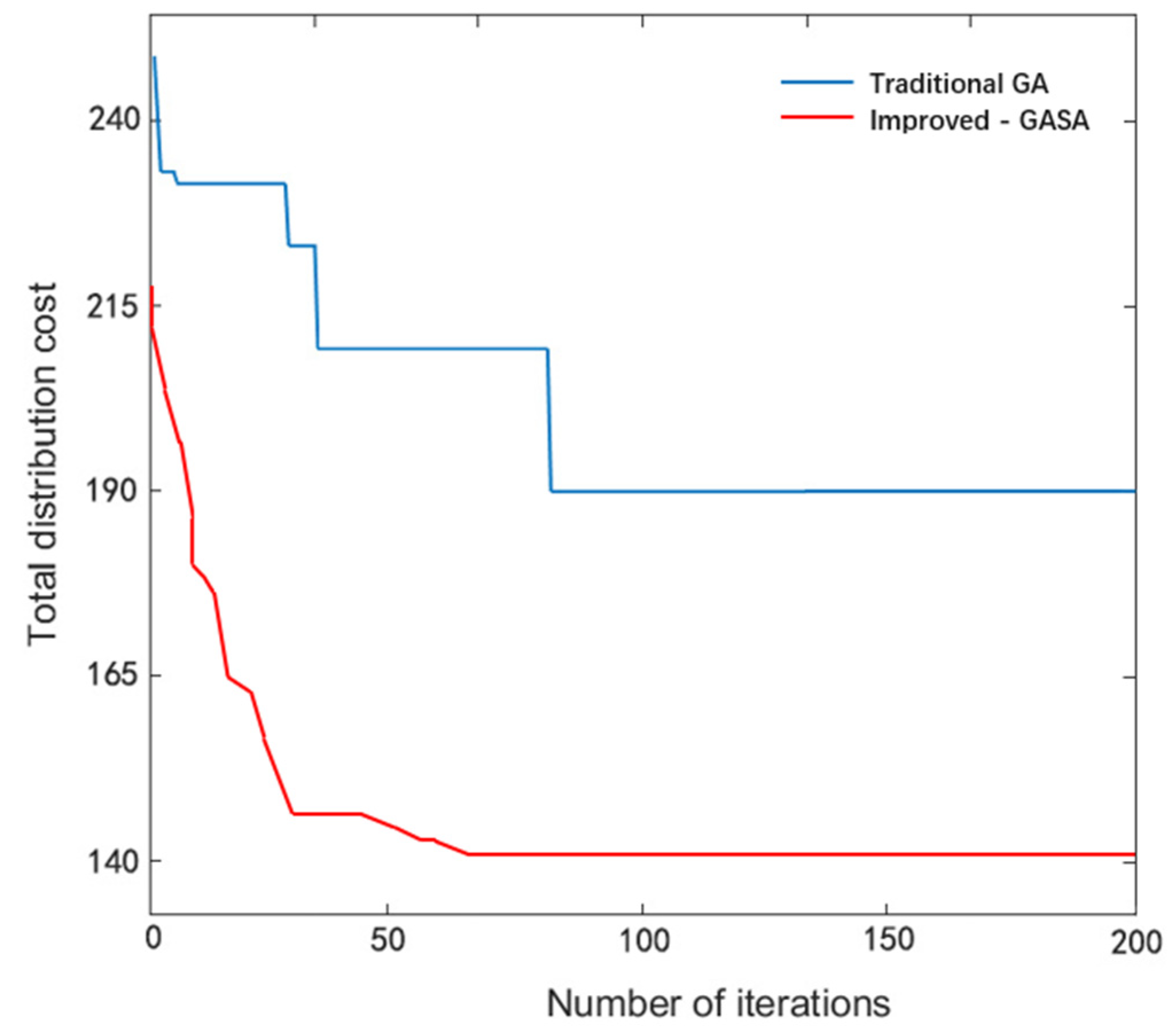
| Type | Variable | Definition |
|---|---|---|
| Collections | ||
| Parameters | ||
| and | ||
| The average speed of the truck | ||
| The average speed of the drone | ||
| Maximum driving range of truck | ||
| Maximum driving range of drone | ||
| Purchasing cost of each truck | ||
| Purchasing cost of each drone | ||
| Truck cost per kilometer | ||
| Drone cost per kilometer | ||
| Maximum load of truck | ||
| Maximum load of drone | ||
| Unit weight of package | ||
| Unit weight of drone | ||
| Customer’s expected time window | ||
| Decision variables | ||
| k | Number of trucks | |
| d | Number of drones |
| Parameters | Variable | Value/Unit |
|---|---|---|
| Maximum load of the truck | 2000 kg | |
| Maximum driving distance of truck | 300 km | |
| Average speed of the truck | 40 km/h | |
| Purchasing cost per truck | 20 CNY | |
| Truck unit travel cost | 0.7 CNY/km | |
| drone maximum load | 30 kg | |
| Customer’s expected time window | [9:00, 17:00] | |
| Customer priority | (0, 1) | |
| Maximum driving distance of drone | 15 km | |
| Average speed of the drone | 50 km/h | |
| Purchasing cost per drone | 10 CNY | |
| Drone unit travel cost | 0.2 CNY/km | |
| The weight of a single drone | 65 kg | |
| Package unit weight | 5 kg | |
| Drone unit service rate | 1.4 | |
| Truck unit service rate | 1.2 |
| Pattern | Tr./Dr. | Delivery Path | Length/km | TDC/CNY | TWL/min |
|---|---|---|---|---|---|
| Truck only | Truck | 0−2−3−7−6−8−9−10−21−30−24−27−25−28−11−16−23−20−22−29−32−38−41−35−39−43−49−48−45−34−42−46−50−40−36−33−37−26−19−31−44−47−12−15−13−18−14−17−5−4−1−0 | 242.36 | 189.65 | 12.33 |
| The two−stage Truck and Drone | Total | / | 239.52 | 148.63 | 4.91 |
| Truck | 0−32−16−9−43−34−46−36−26−47−12−14−0 | 121.46 | 75.37 | 2.49 | |
| Drone1 | 0−2−6−7−3−0, 32−38−41−32, 16−23−11−20−16, 43−49−43, 34−45−48−34, 46−50−46, 36−33−37−40−36, 26−19−26, 12−31−12, 14−18−17−14 | 61.07 | 37.90 | 1.25 | |
| Drone2 | 0−1−4−5−0, 32−29−22−32, 9−8−10−9, 43−35−39−43, 34−27−25−28−34, 46−42−46, 36−30−24−21−36, 47−44−47, 12−15−13−12 | 56.99 | 35.36 | 1.17 |
Disclaimer/Publisher’s Note: The statements, opinions and data contained in all publications are solely those of the individual author(s) and contributor(s) and not of MDPI and/or the editor(s). MDPI and/or the editor(s) disclaim responsibility for any injury to people or property resulting from any ideas, methods, instructions or products referred to in the content. |
© 2024 by the authors. Licensee MDPI, Basel, Switzerland. This article is an open access article distributed under the terms and conditions of the Creative Commons Attribution (CC BY) license (https://creativecommons.org/licenses/by/4.0/).
Share and Cite
Dai, D.; Cai, H.; Ye, L.; Shao, W. Two-Stage Delivery System for Last Mile Logistics in Rural Areas: Truck–Drone Approach. Systems 2024, 12, 121. https://doi.org/10.3390/systems12040121
Dai D, Cai H, Ye L, Shao W. Two-Stage Delivery System for Last Mile Logistics in Rural Areas: Truck–Drone Approach. Systems. 2024; 12(4):121. https://doi.org/10.3390/systems12040121
Chicago/Turabian StyleDai, Debao, Hanqi Cai, Liang Ye, and Wei Shao. 2024. "Two-Stage Delivery System for Last Mile Logistics in Rural Areas: Truck–Drone Approach" Systems 12, no. 4: 121. https://doi.org/10.3390/systems12040121
APA StyleDai, D., Cai, H., Ye, L., & Shao, W. (2024). Two-Stage Delivery System for Last Mile Logistics in Rural Areas: Truck–Drone Approach. Systems, 12(4), 121. https://doi.org/10.3390/systems12040121






